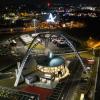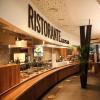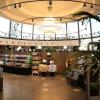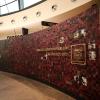Delving back into Villoresi’s futuristic past
A symbol of renaissance for our restart: Villoresi Ovest, icon of Italian design, is back in the news. The historic Autogrill reopened on 22 November 2020 after months of renovation work.
Following the opening in 1947 of the first foodservice point on the Turin-Milan motorway, near the Novara toll-station, built by Mario Pavesi as a “Pavesi biscuit factory refreshment point”, the 2nd most mentioned Autogrill, the Villoresi, was built at Lainate on the Milano-Laghi motorway 11 years on in 1958, with the economic boom in full swing. Its design was so futuristic – reflecting the ingeniousness of the architect Angelo Bianchetti – that many thought it looked more like a missile launch pad than a service area foodservice. Its circular glass façade structure - topped by three arches bearing the Pavesi sign 51 metres above the ground - immediately imbedded itself in the collective imagination. It was even featured in the pages of Life (26 September 1960) as one of the works symbolizing Europe’s economic revival.
Photos - Archive Arch. Jan Jacopo Bianchetti
"Villoresi Ovest has always been a symbol of rebirth. As far back as 1961, the magazine LIFE put it on its front cover to illustrate how modern our country was. And now, once again, we want the renovated facility to be a symbolic bridge between past and future, a tangible sign of determination to relaunch Italy - and all of us – in these fraught circumstances”.
Gianmario Tondato - Autogril CEO Group
Immediately an emblem of "revival"
If the creation of the Villoresi Autogrill marked the transition from the post-war years to the economic boom that launched the so-called affluent society, its preservation/renovation today represents a new idea of revival to lead the country out of a complex situation defined by the Covid-19 pandemic. With immense determination and despite the lockdown – which interrupted the work begun in February 2020 - the team has achieved its objective, the relaunching of this icon of Italian architecture on schedule.
"The new Villoresi Ovest offers the best of the dining experience we’ve developed over these years of revival and is the finest expression of our vision and determination to achieve increasingly significant results".
Andrea Cipolloni – CEO Europe
The renovation reflects a deep respect for the building’s original design and thus embodies the Group’s links with tradition. At the same time, it was able to carry out a modest aesthetic revisiting and also an upgrading to new building standards, thus staying true to Autogrill’s mission as an innovator in foodservice for travellers. The majestic tripod arching over the facility was not demolished, most of the work being on the structure beneath it, which has been rebuilt to the latest construction standards and in line with current safety regulations. A work of preservation that has in no way spoilt the allure of the original idea. Quite the contrary, it has laid down a new milestone in the Group’s iconic history.
As always, Autogrill Group’s best innovations also reflect its capacity to team up with exceptional partners. In this case, the players were different but all prestigious and capable of bringing value-added to the project. For a start, the architects, Andrea Langhi Design, stayed true to the classic design, doing nothing to alter the iconic arching tripod but enriching the ambience with technological and more contemporary materials and systems.
Sustainability at the heart of the project
The 1958 restaurant: the coming together of the traditional and the contemporary
Such an important reopening called for a major novelty, like the Concept 1958 created especially for the occasion and clearly inspired by the year of Villoresi’s foundation. A brand designed to encapsulate the best of what Autogrill Group is offering on its network, from 1st courses by Andrea Ribaldone, via Renato Bosco’s pizzas to desserts by Sal De Riso.
One of the founding concepts of Autogrill’s business is to have sustainability at the centre of every new project or idea, an all-encompassing concept and badge of identity that stimulates the whole Group to improvement and growth. No surprise then that Autogrill chose LEDs to ensure uniform lighting and reduce the facility’s energy impact and installed a solar power system, double glazing with UV filtering film (for high performance in terms of thermal insulation), high energy efficiency heat pumps and an air conditioning system that provides natural climatization (remote controlled by a BMS - Building Management System).
Used alongside all these latest generation systems are some highly innovative materials: the Active Ceramic flooring, for instance, is anti-bacterial, self-cleaning, anti-pollutant and anti-odour all day long, while the Airlite paint adopted is applied like normal paint but thanks to its innovative technology it purifies the air and sanitizes the ambience by naturally generating negative ions on the surface where it’s applied, so that air coming into contact with it is naturally purified. Many of the other materials used are the fruit of all-Autogrill patents like WASCOFFEE®, made with coffee waste, and WASORANGE®, made with waste from juiced oranges.
But sustainability as an all-embracing concept is not only environmental: it also asks questions about fairness and inclusion. To this end, Autogrill is working with Cometa, an association actively engaged in providing accommodation and education to children and young people living in difficult economic, social and personal conditions. Projects include Contrada degli Artigiani, a co-operative formed in 2008, where skilled craftspeople teach traditional trades to these young people and, together, make high quality products in the fields of furnishing and interior decoration. One example is the large barrique wood table in the middle of the restaurant beneath the baroque-inspired teardrop lamp: it’s made of recycled materials from wooden wine barrels and Murano glass waste.





















